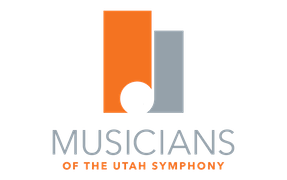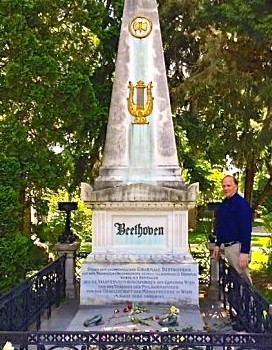Back in Vienna
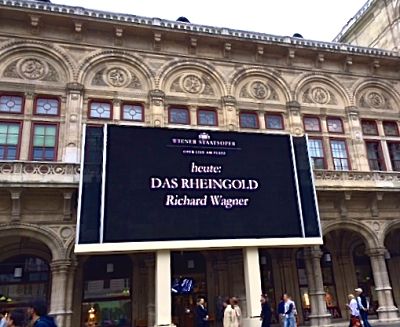
Opera on the Square
If you are on a “musical journey” in Vienna, it’s hard to do it all; however, a priority for us was to see Wagner’s “Ring of the Nibelung”. This cycle of four epic operas was first presented at the Bayreuth Festival 99 years ago and changed music as we knew it. We tried to procure tickets for all four performances come rain or shine. Two of them were free, but our seats were outside of the opera house! Being on the wait list gave us another European experience when no seats were available inside. We saw “Das Rheingold” and “Die Walküre” on the plaza in front of a huge screen. As with the HD performances from the Metropolitan Opera, these performances featured different camera angles and interviews from the cast and conductor (Simon Rattle). The graphics made the opening scene of “Das Rheingold” look like the characters were under water. The voices were powerful, and the orchestra was excellent. Seeing a Wagner opera is like watching a long story. You begin to notice that there are few, if any, cadences. Seeing it outdoors means that the story can be accompanied by the sounds of the city. Honking horns, sirens, whirling helicopters, chanting gangs and horses clopping down on the cobblestone streets was the “norm”. The audience outside is much more transient. Sitting for two and a half hours straight can be a challenge, but more so when it rains, which was our experience when watching “Das Rheingold”. Fortunately, we brought our foul weather gear. Thanks, Weather App! “Die Walküre” is more than four and a half hours long but comes with two intermissions. On the second break, we left to get something to drink and returned to see our seats occupied. We stood until an opening presented itself and sat for the remainder of the opera. Two hundred or so fans around us joined those inside to applaud the production.

Strauss Waltzes at the Kursalon
We also wanted to experience the “Viennese” waltz while in town, so we attended a concert of Strauss waltzes in the touristy Kursalon where Strauss conducted during the 19th century. When you say the name Strauss in Vienna, one thinks of a family dynasty that spanned decades. The “Waltz King” (Johann II) was the son and brother of famous composers and is the one that packs in the crowds on a daily basis. Personable Viennese gentlemen in period costumes stroll the streets selling tickets to as many as six different nightly concerts featuring the music of Strauss, Lehar, Mozart, Von Suppé, etc. The one we attended was sold out, and there was a second small orchestra (also playing waltzes) two floors below us that played to a full house as well. The show was entertaining, and I kept thinking that this might be a good city to be a freelance musician if you like Strauss.
We enjoyed a wonderful performance of Rossini’s opera “La Cenerentola”. It was set in 1950’s Italy and starred Serena Malfi in the title role with some great sets and costumes. After hearing such wonderful music, it seemed sad to think that Rossini spent so much of his life NOT composing. His love of food and entertaining was legendary.
Statues, streets, cafes and bakeries honor the many composers who called Vienna their home. We enjoyed seeing the apartments of Mozart and Beethoven, having cake and coffee at the Mozart Cafe, snapping pictures next to memorial statues of Schubert, Mahler, Brahms and more and hearing their music. It was often played in stores and restaurants.
We made a trip to the Esterhazy Palace where Haydn worked for more than forty years! His home was modest, but the palace was not. Our tour of the palace made it possible to see the beautiful concert hall where many of “Papa” Haydn’s 104 symphonies were first performed. We often imagined being able to travel back in time to hear such concerts.
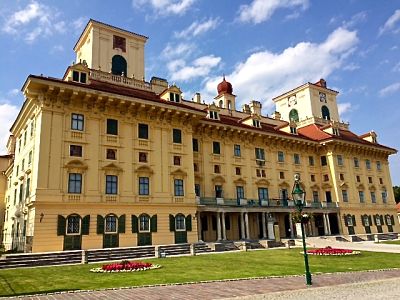
Esterhazy Palace
One of the more interesting concerts of our sabbatical was hearing the Vienna Philharmonic conducted by Simon Rattle where the second half of the performance consisted of eleven movements from different Haydn symphonies. The variety of musical personality and inventiveness was really amazing and highlighted why I love hearing Haydn’s music. The orchestra played so beautifully, especially in the slower movements. There is pride in their music-making and the “Viennese” sound. This sound is reflected in the carryover of musical instruments, most notably the oboe. Often when I hear an oboist from Vienna, my first reaction is that the tone quality is like the English Horn but with higher notes. The instruments themselves are more creatively designed than French oboes. They have bulbous curves and keys which make me ask, “What does this do?” Still, beautiful phrasing is beautiful phrasing.

Musikverein in Vienna
Since our sabbatical began, our tally of performances has hit one hundred, and we are still going strong. Number one hundred was a performance by the Vienna Symphony conducted by Jaap van Zweeden. The program featured Beethoven’s Piano Concerto No. 2 and Shostakovich Symphony No. 5. David Frey was the soloist and played with a strong degree of technical accuracy. The Symphony was exciting, especially the tutti passages.
We enjoyed seeing the art collection at the Belvedere Palace and the Secession Museum. Gustav Klimt was the featured artist in both museums, “The Kiss” in one and the “Beethoven Frieze” in the other. Like all great artists, his work draws you in. Another significant work was the large painting of “The Philharmonic” by Max Oppenheimer. It took him 26 years to complete and measures about 20 feet across. Gustav Mahler is on the podium. We both agreed that turning the Belvedere Palace (or any palace) into an art museum seemed like a good idea.

Belvedere Palace
We have seen more than twenty operas since the sabbatical began, giving us a wide range of repertoire. “Salome” by Richard Strauss was especially exciting. Gun-Brit Barkmin sang the starring role, and the Vienna Philharmonic was in top form. The costumes and sets looked like the art work of Gustav Klimt. The director did a great job of capturing the madness of Salome.
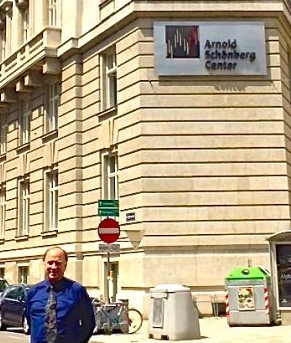
Arnold Schoenberg Center
We saw the Arnold Schoenberg Center, which happened to be located near our apartment. There was a room which duplicated his studio in L.A., numerous videos of his orchestral and chamber works being performed and interviews with the players and conductors. It was very interesting.
Big cities attract big orchestras from around the globe. The Philadelphia Orchestra came to town, so we went to hear them play the Shostakovich Violin Concerto and Tchaikovsky’s Symphony No. 5. Oddly enough, this was our fifth time hearing the Shostakovich Violin Concerto since the sabbatical began! This doesn’t matter when you are hearing such a great soloist (Lisa Batiashvili) and a great orchestra. Ms. Batiashvili’s playing was poetic and exciting. I was especially thrilled to hear Mark Gigliotti (bassoon), David Cramer (flute) and Holly Blake (contra bassoon) play starring roles in the demanding Shostakovich Concerto. Mark, David and I were friends/classmates at Curtis, and their beautiful sounds have only gotten better with time. On the second half, Yannick Nezet-Seguin led the orchestra in a fabulous performance of the Tchaikovsky. There are so many star players in the Philadelphia Orchestra, but I have to mention clarinetist Ricardo Morales, oboist Richard Woodhams and horn player Jennifer Montone. All had inspiring moments. Former Utah Symphony musicians Jeff Kirschen, Shelley Showers and Dara Morales all contributed with typical excellence. During the days that followed, we enjoyed spending time with Dara, Mark, Holly, David, Jonathan Blumenfeld and his close friend from Berlin Ina Lontorfos. With all the Austrian pastries available, it wasn’t too hard filling our social calendar and my sweet tooth.
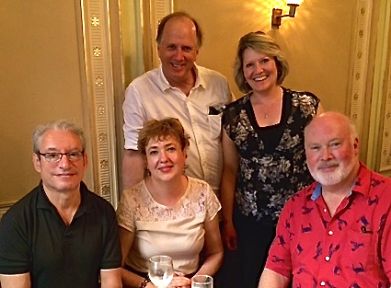
Jonathan Blumenfeld, Ina Lontorfos, Bob, Lisa and David Cramer
The University of Music and Performing Arts in Vienna is one of the leading music schools in Europe. Antonio Salieri founded this school in 1817, and some former instructors on the roster include Paul Hindemith, Pablo Casals, Fritz Kreisler and Pierre Boulez, to name a few. A large student body of over 3000 study music, theater, film and more. One of the instructors is Alexandra Turk, who Lisa has known for many years through family connections. Alexandra is a physiotherapist who helps musicians understand breathing, mental health and physical health as it relates to playing their instruments. She gave us a great tour of the school, and we met some of her colleagues. Playing an instrument is more involved than just playing the right notes, and this school seems committed to helping young musicians in every way possible.
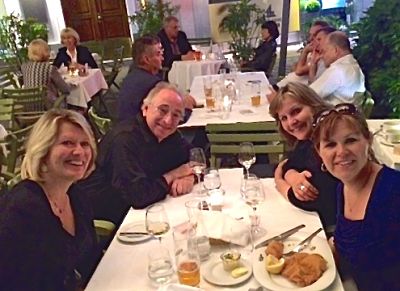
Lisa, Mark Gigliotti, Holly Blake and Dara Morales
Two hundred and one years after it’s premiere in Vienna, we went to see “Fidelio”by Beethoven. It was another exciting production where one of the main characters was the orchestra! When the Vienna Philharmonic played the “Leonore” Overture No. 3 before the final scene, the applause following the final chord was startling! It is part of that “Viennese pride” mentioned earlier. The voices were superb and the orchestral writing thrilling. One could understand the argument that this is the best opera ever written. We felt very fortunate to have been there.

Alexandra Turk and Lisa Byrnes
We’ve decided to make a trip in two days to Budapest, home to Bartok and Kodály. We are trying to pack it all in before our flight back to the States in a few days. Someone recently suggested we might experience “culture shock” upon our return. Maybe if I learn how to make a good apple strudel that will help.
– Robert Stephenson and Lisa Byrnes
